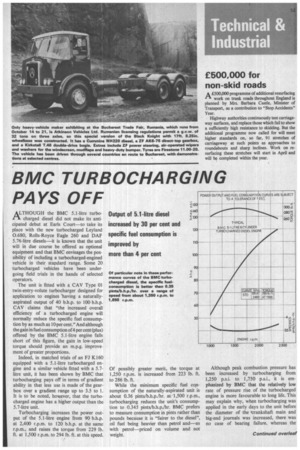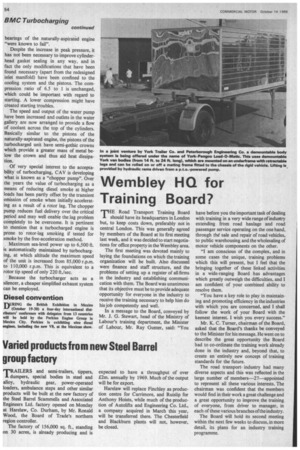BMC TURBOCHARGING PAYS OFF
Page 55

Page 56

If you've noticed an error in this article please click here to report it so we can fix it.
ALTHOUGH the BMC 5.1-litre turbocharged diesel did not make its anticipated debut at Earls Court—to take its
place with the new turbocharged Leyland 0.680, Rolls-Royce Eagle 260 and DAF 5.76-litre diesels—it is known that the unit will in due course be offered as optional equipment and that BMC envisages the possibility of including a turbocharged-engined vehicle in their standard range. Some 20 turbocharged vehicles have been undergoing field trials in the hands of selected operators.
The unit is fitted with a CAV Type 01 twin-entry-volute turbocharger designed for application to engines 'having a naturallyaspirated output of 40 b.h.p. to 100 b.h.p. CAV claims that "the increased overall efficiency of a turbocharged engine will normally reduce the specific fuel consumption by as much as 10 per cent." And although the gain in fuel consumption of 4 per cent (plus) offered by the BMC 5.1-litre engine falls short of this figure, the gain in low-speed torque should provide an m.p.g. improvement of greater proportions.
Indeed, in matched trials of an FJ K160 equipped with a 5.I-litre turbocharged engine and a similar vehicle fitted with a 5.7litre unit, it has been shown by BMC that turbocharging pays off in terms of gradient ability in that less use is made of the gearbox over a gradient range up to 3.5 to I. It is to be noted, however, that the turbocharged engine has a higher output than the 5.7-litre unit.
Turbocharging increases the power output of the 5.1-litre engine from 90 b.h.p. at 2,400 r.p.m. to 120 b.h.p. at the same r.p.m., and raises the torque from 229 lb. ft. at 1,500 r.p.m. to 294 lb. ft. at this speed. Of possibly greater merit, the torque at 1,250 r.p.m. is increased from 223 lb. ft. to 286 lb. ft.
While the minimum specific fuel copsumption of the naturally-aspirated unit is about 0.36 pints/b.h.p./hr. at 1 ,500 r.p.m., turbocharging reduces the unit's consumption to 0.345 pints/b.h.p./hr. BMC prefers to measure consumption in pints rather than pounds because it is "fairer to the diesel", oil fuel being heavier than petrol and—as with petrol priced on volume and not weight.
Although peak combustion pressure has been increased by turbocharging from 1,250 p.s.i. to. 1,750 p.s.i., it is emphasized by BMC that the relatively low rate of pressure rise of the turbocharged engine is more favourable to long life. This may explain why, when turbocharging was applied in the early days to the unit before the diameter of the trankshaft main and big-end journals was increased, there was no case of bearing failure, whereas the bearings of the naturally-aspirated engine "were known to fail".
Despite the increase in peak pressure, it has not been necessary to improve cylinderhead gasket sealing in any way, and in fact the only modifications that have been found necessary (apart from the redesigned inlet manifold) have been confined to the cooling system and the pistons. The compression ratio of 6.5 to I is unchanged, which could be important with regard to starting. A lower compression might have created starting troubles.
The speed and output of the water pump have been increased and outlets in the water gallery are now arranged to provide a flow of coolant across the top of the cylinders. Basically similar to the pistons of the naturally-aspirated engine, the pistons of the turbocharged unit have semi-gothic crowns which provide a greater mass of metal below the crown and thus aid heat dissipation.
Of very special interest to the acceptability of turbocharging, CAV is developing what is known as a "chopper pump". Over the years the value of turbocharging as a means of reducing diesel smoke at higher loads has been partly offset by the transient emission of smoke when initially accelerating as a result of a rotor lag. The chopper pump reduces fuel delivery over the critical period and may well enable the lag problem completely to be overcome. It is pertinent to Mention that a turbocharged engine is prone to rotor-lag smoking if tested for smoke by the free-acceleration method.
Maximum sea-level power up to 6,500 ft. is automatically maintained by turbocharging, at which altitude the maximum speed of the unit is increased from 85,000 r.p.m. to 110,000 r.p.m. This is equivalent to a rotor tip speed of only 220 ft./sec.
• Because the turbocharger acts as a silencer, a cheaper simplified exhaust system can be employed.
































































































































